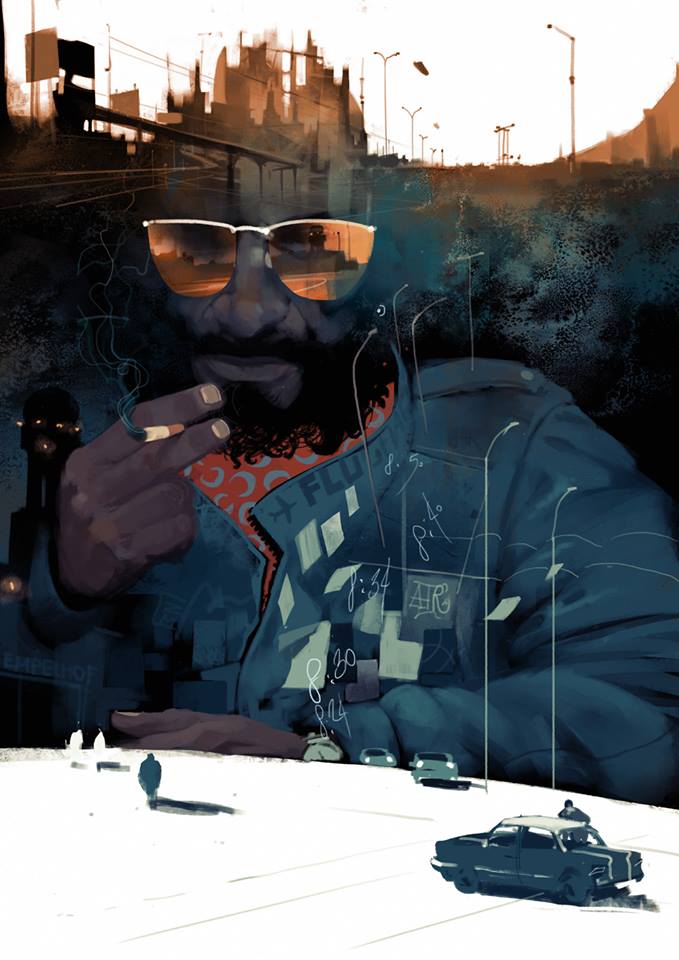Bachir und die Welt von Metropolis
written by Tim Vogler
Die Figur Bachir entwickelt sich in Cosimos neuem Entwurf und nimmt die Welt von Metropolis in sich auf. Im Hintergrund seht ihr – quasi aus seinem Kopf erwachsend – die Himmelsriesen des Märkischen Viertels und die Stelzenbahn, die über den stadtnahen Wilden Wald darauf zuführt. Weiter unten sind der nachgebaute Flughafen Tempelhof II und Elemente aus Mauerberlin zu erkennen.
Cosimo ist noch nicht fertig, er arbeitet an weiteren Details. U. a. ist der Opel Ascona noch nicht als solcher zu erkennen, auch aus der Jacke soll noch eine »City Wall« werden. Da aber um Bachir herum schon diese spezifische und verrückte Berlin-Welt zu erkennen ist und weiter geformt wird, möchte ich Euch an den Gedanken/Instruktionen teilhaben lassen, die ich Cosimo heute gegeben habe. Dadurch erfahrt ihr mehr über die Person Bachir und das Berlin des Jahres 2049. Wenn das Bild fertig ist, poste ich das Kapitel des Buches, in dem Bachir vorgestellt wird und das Bild zusammen. Dadurch erhaltet Ihr einen kleinen Einblick darin, wie das Zusammenspiel aus Bild und Text später im Buch funktionieren wird.
***
– The look of Bachir is great but don´t make him look too old. He´s just 33 years old. He likes to drink (sometimes way too much) and he has drug episodes if he´s down He looks older than he is. He knows life, he´s seen a lot and he got a little bitter, but he still got that young arab playboy charme. In normal days he´s smiling and joking a lot, sometimes just to fight the sadness inside. He´s strong but not the most sporty one. He just likes cake and sweets too much. Sometimes he´s fighting back with sports and workouts, but more often he´s letting go. He doesn´t wear tight clothes so nobody sees his belly etc.. He can move fast and fight good. You can call him Bear, Mountain, Mr. T etc. to portrait him, but if you´re a skinny nasty »Bengel« (like Manolo in the book), you can also call him »fatboy« (although it would´t be proper and fair, because he´s not really fat.)
– Also to have it in mind for the bigger picture: After the Große Katastrophe there was polution and riots in Brandenburg and other parts of germany, especially in the eastern ones. I don´t explain that in detail in the book, I leave it up to the fantasy of the readers. But it´s sure that there has been chaos and people had to flee there villages and towns. Everybody in that area headed to Berlin. That´s why there is literally nothing in Brandenburg anymore. At least government pretends that there´s nothing and it´s dangerous to go there.
Because of the specific pollution in the Brandenburg Area, the forest grew strangely and wild. It took over the land and mutated Wolfs and other animals are crawling in it. That´s why the big and clean city is surrounded by forest. There is also a fence to hinder the wolfs from entering the City (and also (probably more importantly) to hinder the folks to leave the controlled area of the city). But it´s not such a massive one as near Märkische Viertel. It should be effective and dangerous but not be noticed as such. The fence around the MV instead is a monument, that should produce fear and keep people away from doing »stupid things«.
– So the modern Berlin is surrounded by forest. The Normalstadt looks similar in some parts but completely different in others than our Berlin of today. You have the Stelzenbahn, The Regierungsviertel with the Halle der Whisperer and the old museums and buildings and the glas palaces in the centre. The loft buildings at the Spree and the gated community for the Rich at the old Tempelhofer Feld. The modern apartment houses with planted facades and roofs in Kreuzberg and other parts. Greened big boulevards with trees in the middle and bike lanes with garden elements. Electric cars and Buses on all boulevards, that are guided by computer algorithms mostly with a constant flow through the city. You have these new traffic systems/city elements and of courses »normal Streets« and old buildings that look like the houses in our days. The ruins and the free spaces moved to Mauerberlin and the Kulissenviertel though. The entrepreneurs live and work in iBerlin, a huge startup-laboratory on the land of the old airport Tegel, where the young guys from all over the world develop products and ideas and spin off after a while.
Berlin Normalstadt is different, it »grew up«, it´s a »normal Metropolis«. There´s just one bigger part, that is a bit like the old »poor and sexy« Berlin of older days. It´s called the »Ciudad Escondia« and it´s in the outskirts close to the fence. Here the Expats from Spain, Italy, South America and all other parts of the world can enjoy low rents and a certain tolerance, they would not find in the stricter city, that controls everybody and the habits of everybody to »keep them safe«.
– So that´s pretty much a microcosm, but a different one than Berlin of today. And all that is surrounded by forest. And in the forest like islands you have the monstrous Märkische Viertel with the Stelzenbahn track through the Fence and the Todesstreifen (where they cut the woods on both sides) towards the MV with the Himmelsriesen in its centre. That´s in the North. In the east you have Mauerberlin as another island in the forest. And South/Southeast you find the 20er-Jahre-Berlin. You go to these islands as you go to the few lakes that are cleaned and safe: With the BVG-Shuttle.

Neueste Kommentare